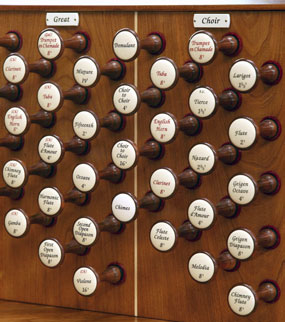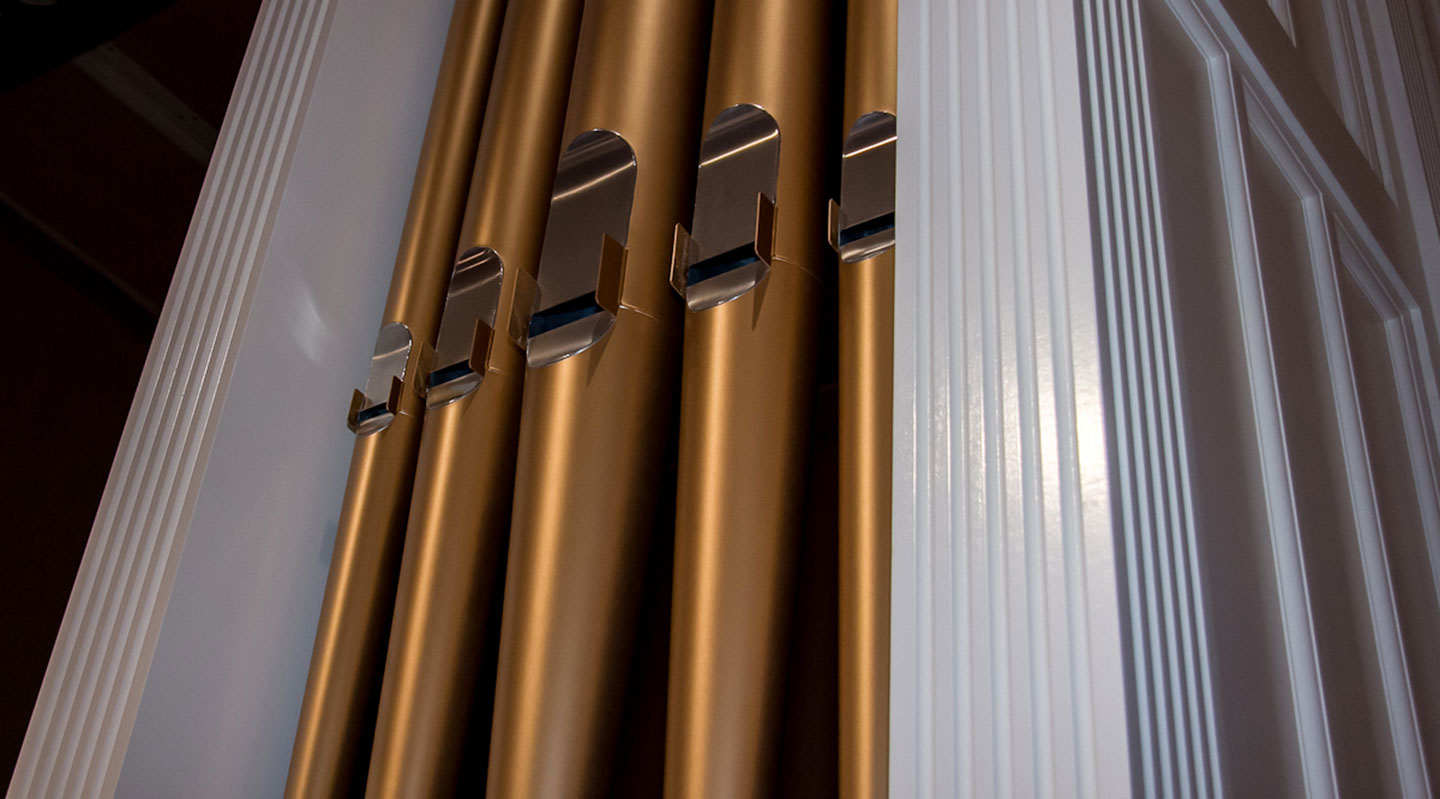Strings
Strings are organ pipes which are constructed and voiced to resemble the character of bowed string instruments (e.g., violins, violas, ’cellos, double basses). With their smaller scaling and narrow mouths with lower cut ups, string pipe tone is characterized by a weaker fundamental and stronger upper harmonics.
Strings are needed to round out the tonal palette of the organ. They add richness, texture and color to the ensemble with their distinctively refined tone. Used en masse, they can also simulate an orchestral string section in symphonic transcriptions. Softer toned strings, Dulciana, Dolce and Aeoline are used in moments of meditation and convey a “heavenly peace” with their dulcet, singing quality.
In his great work Organ Stops And Their Artistic Registration, George Ashdown Audsley states:
“The pipes of the Violin (string variety) are invariably cylindrical; and, chiefly on account of their extremely small scale, should be made of tin or very high-grade alloy of tin and lead. They are usually slotted, and tuned by a metal slide in good work. It is questionable if slotting is favorable to the tone, for it has a tendency to impart a horn-like timbre. The mouths of the pipes vary slightly in their widths. In the largest scale adopted by Thynne (a noted voicer), the mouth of the CC pipe is two-ninths its circumference; this width being graduated to one-third the circumference at treble c2, that proportion being carried to the top note. The heights of the mouths vary between one-fourth and one-third their widths, according to the wind-pressure used, and the character of the tone desired. The Violin has been artistically voiced on pressures varying from 2 1/2 inches to 15 inches. The Violin is invariably, and of necessity, voiced with the harmonic-bridge. The harmonic-bridge is semi-cylindrical in form, and of a hard alloy. It is carried between the ears and its position is a matter of extreme nicety. Cylindrical bridges, formed of aluminum tubing or some hard wood, are commonly used by voicer.”
The harmonic-bridge, mentioned by Audsley, is commonly seen as a small piece of wooden dowel tacked between the ears of the pipe. Its placement is indeed a “matter of extreme nicety”. The function of the harmonic bridge or roller beard, as it is more commonly called, is to help the larger pipes speak their fundamental without over blowing to the next harmonic. String pipes require skillful voicing to bring out their complex character.

Strings go by many names. Most commonly they are given the names of stringed instruments, which have gone out of use. For example: Viol, Viola D’ Gamba, Viola D’ Amore, Violone, are now recognizable to organists as stops of the string variety. But how many of you realize that these were actually ancient bowed string instruments which were the immediate predecessors of the violin and the violin family? Stop names also reflect the modern instruments: Violin, Viola, Violoncello, Contrabass or Double Bass. Viol, Viola D’ Gamba, Viola D’ Amore, Violin, Viola and Violoncello are all stops of 8′ pitch although Violin or Violina can also be of 4′ pitch. Violone, Contrabass and Double Bass are Stops of 16′ pitch and appear mostly in the pedal division. Gemshorn is also a type of string with pipes conical in shape becoming narrower at the top. However, Dolcan pipes, also conical, is inverted to the Gemshorn, having its taper increasing from bottom to top. Another name that is more of a generic term is Salicional. This term can be used to denote any kind of string pipe.
Strings are rarely used as solo stops but are more generally used in conjunction with others. One of the most common and pleasing combinations is the Swell 8′ string and the Vox Celeste. The Vox Celeste is a stop that is inserted into a specification to be drawn with the main 8′ string of a division. This stop is identical to the main string in every respect (scaling, construction, voicing) except that it is tuned slightly sharp in pitch. This “off-tuning” gives an ethereal tremolo or vibrato effect to the sound. The stop usually does not run the entire compass of the manual, starting at tenor or second C on the keyboard. The term Vox Celeste means celestial voices and if you play a note or chord and let your imagination run away, you can almost hear the angels singing. This effect can also be said to simulate the sound of many stringed instruments played in concert.
Another type of “Celeste” is called Unda Maris. This term means “waves of the sea”. The Unda Maris is intended to be drawn with the Dulciana and resembles that stop in all respects except tuning. It is tuned slightly flat in pitch and therefore gives a graver more mellow kind of tremolo than a Celeste. Although the Dulciana and Unda Maris were “standard” fixtures on older three manual organs (usually placed in the choir) they are now infrequently seen in new specifications.
Strings can be voiced in many different ways, from soft and smooth to raspy and highly acute. But however they are voiced, they are and have always been an essential element in a well-rounded specification and will remain so, now and into the future.

Different forms of String Pipes
Left to right:
- Viola Pomposa 8′
- Dolce 8′
- Viole de Gamba 8′
- Viola Celeste 8′
- Viola Celeste 8′
- Dolce Celeste 8′
I thank you for your interest in these articles and I sincerely hope they have been informative. I also have to thank a few resources both for information and for illustrations, which I have used in this and the previous articles:
Organ Stops And Their Artistic Registration – by George Ashdown Audsley, LL.D.
The Art Of Organ Voicing – by L. G. Monette
Dictionary Of Pipe Organ Stops – by Steven Irwins

